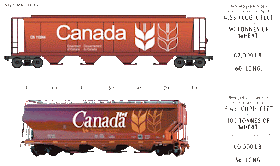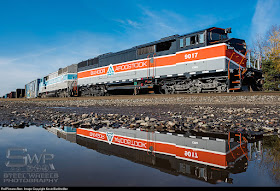 |
The Mehano/IHC Mogul from the second
PC Express train set. |
Christmas and trains--they still go together for many people.
For lots of model railroaders, that's where their interest in the hobby started: With a train set under the tree.
But good train sets were hard to find in the 1990s when Boris Polakow, Vice President of Canadian Sales Development for Loblaws (owner of Real Canadian Superstore), decided it was time for a quality, affordable train set.
Polakow, who had been fascinated by trains since a child, was distressed to see families bring low-quality train sets that broke “a day after Christmas,” as he told me in an interview in 2001.
He thought that if someone sold a high-quality train set at an affordable price, people would buy them. His colleagues at Loblaws weren’t so sure.
In 1992, Polakow proved them wrong.
The first run of 10,000 President’s Choice/PC Express (named after the line of Loblaw’s food products) train sets sold out within days of being released before Christmas, that year—and a tradition was started.
 |
| The first set, 1992. |
Between 1992 and 2006, a total of 11 sets were released (they skipped 1996, 2000, 2003 and 2004).
Sold only in Canada, they had names like the PC Express, PC Insider’s Express, the Mountain Express, Camelback Express, Pacific Express, 6060 Bullet Nose Express, Yard Bull Express, Mini Chef’s Express and Big Ten Express.
The rolling stock was toy-like—the cars had truck-mounted horn-hook couplers, and many featured President’s Choice products like cookies, cola, juice, pizza and detergent, among other things.
The locomotives, on the other hand, were pretty good—especially the steamers. (All but two of the sets featured steam locomotives.)
Manufactured by Mehano in the former Yugoslavia, the units weren't always true to the prototype (e.g. a CPR Camelback, or the wrong tenders), and had only basic details.
And yet, they were smooth runners; some modelers bought the sets, priced at between $80-$100, just for the locomotives.
A few used them as starting points for super-detailing and kitbashing projects (see
Canadian Railway Modeller Train 6, Track 6 and Train 7, Track 1.)
Of note was the company's model of the CNR's 6060-series U-1-f 4-8-2. It was not an exact replica of that famous bullet nose unit, but it was notable for being the first-ever attempt by a manufacturer to reproduce that locomotive's conical nose in plastic.
 |
| The PC Express Bullet Nose 6060 |
One thing that Polakow didn’t expect was that the sets would become collectors items; many people who bought them never took them out of the box, keeping them as collectibles.
Sets can still be found advertised as unopened on online auction sites.
The best source of information about President’s Choice train sets is
Ragnar Torfason’s President’s Choice train set web page.
On it you can find everything you want to know about each set.
 |
| The 5th set in the series. |
I never bought a President's Choice train set. But in 2012 Canadian Railway Modeller editor Morgan Turney brought a 2-6-0 Mogul locomotive from set #2 over to run on the M & M Sub.
He had recently acquired the unit, and wanted to see it run. I gladly obliged—I rarely run steam on my early-1990s layout. It ran great, and looked good, too, as the photos at top and below attest.
So, at Christmastime, we can remember a tradition now sadly gone, and acknowledge and thank Boris for his contribution to the hobby--for his dream of making quality, affordable train sets for Canadian families.

















































